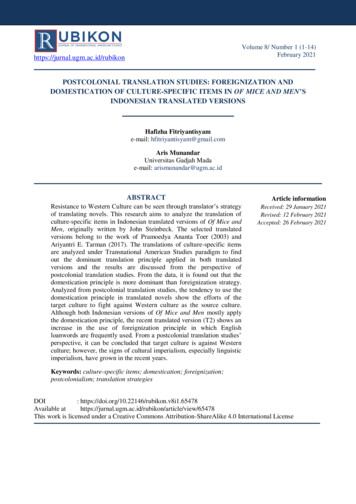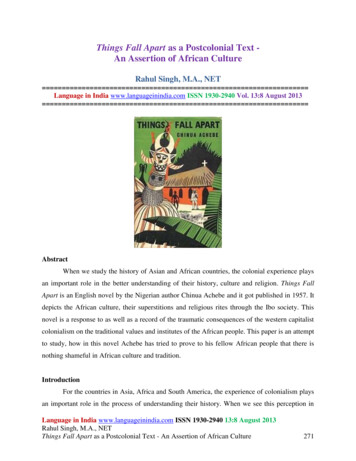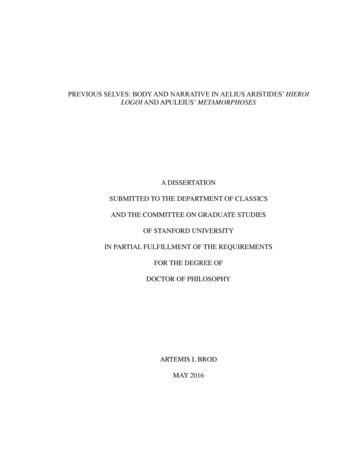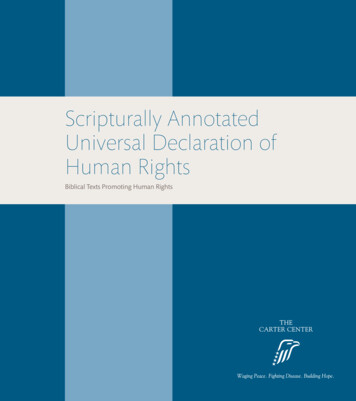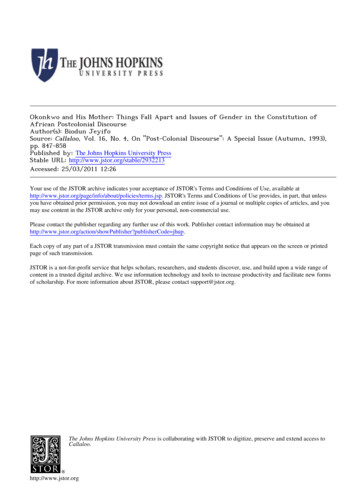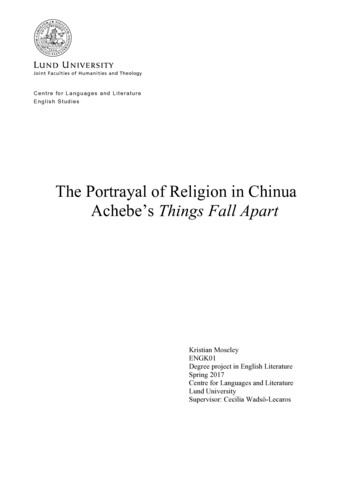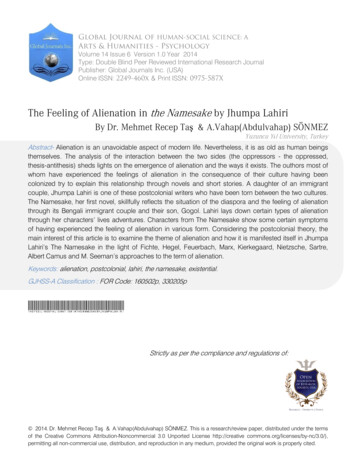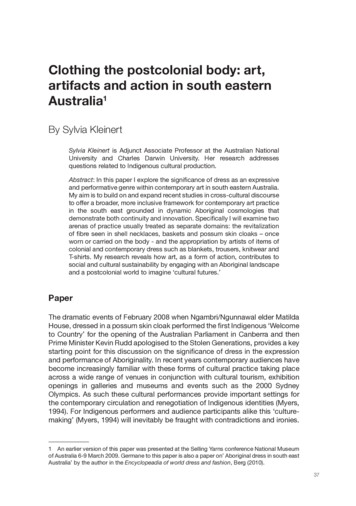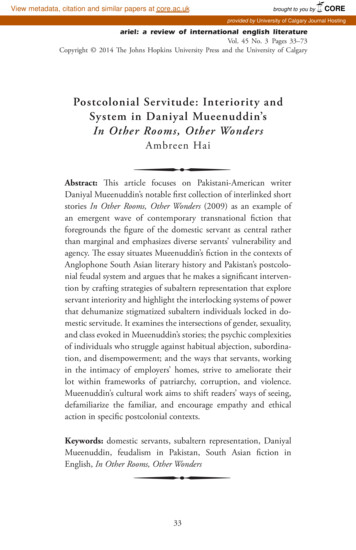
Transcription
View metadata, citation and similar papers at core.ac.ukbrought to you byCOREprovided by University of Calgary Journal Hostingariel: a review of international english literatureVol. 45 No. 3 Pages 33–73Copyright 2014 The Johns Hopkins University Press and the University of CalgaryPostcolonial Servitude: Interiority andSystem in Daniyal Mueenuddin’sIn Other Rooms, Other WondersAmbreen Hai Abstract: This article focuses on Pakistani-American writerDaniyal Mueenuddin’s notable first collection of interlinked shortstories In Other Rooms, Other Wonders (2009) as an example ofan emergent wave of contemporary transnational fiction thatforegrounds the figure of the domestic servant as central ratherthan marginal and emphasizes diverse servants’ vulnerability andagency. The essay situates Mueenuddin’s fiction in the contexts ofAnglophone South Asian literary history and Pakistan’s postcolonial feudal system and argues that he makes a significant intervention by crafting strategies of subaltern representation that exploreservant interiority and highlight the interlocking systems of powerthat dehumanize stigmatized subaltern individuals locked in domestic servitude. It examines the intersections of gender, sexuality,and class evoked in Mueenuddin’s stories; the psychic complexitiesof individuals who struggle against habitual abjection, subordination, and disempowerment; and the ways that servants, workingin the intimacy of employers’ homes, strive to ameliorate theirlot within frameworks of patriarchy, corruption, and violence.Mueenuddin’s cultural work aims to shift readers’ ways of seeing,defamiliarize the familiar, and encourage empathy and ethicalaction in specific postcolonial contexts.Keywords: domestic servants, subaltern representation, DaniyalMueenuddin, feudalism in Pakistan, South Asian fiction inEnglish, In Other Rooms, Other Wonders 33
Ambreen HaiHer presence was slight, and went unnoticed. But when illnessor indisposition kept her away, she was seen everywhere: in thedirty cups and saucers, upon the dusty furniture, in the sheetsof unmade beds.Rohinton Mistry, Family Matters (64)In a novel occupied with the difficulties of a Parsi family in Bombay,Rohinton Mistry pauses briefly to notice what often goes “unnoticed”both in the home and in the text: the family’s domestic servant whoselabor is noticed only when it is absent; a female body on which thehousehold depends but which is “seen” only in the physical traces ofwork not done; a person defined negatively in terms of “unmade” bedsand unclean cups (64). Indeed, the female servant is not seen in FamilyMatters, which notes her invisibility, but does not make her any morevisible. Perhaps this is because Mistry, a male, middle-class IndianCanadian writer, is too cautious to risk the challenges of representingthe subaltern subjectivity of an illiterate domestic female servant andis clear about his focus on the (not unrelated) problems of obligation,dependency, intimacy, aging, and gender dynamics within one middleclass family.Yet I begin with Mistry’s percipient observation because it pointsto a growing interest among his contemporaries to address this challenge, and it points to a new wave of South Asian fiction in Englishthat explores the phenomenon of domestic servitude. In British dramaand fiction from the Renaissance to the nineteenth century, a foundational tradition for Anglophone postcolonial writers, servants are eitherabsent as protagonists (unsurprisingly, given that literary and literatestorytellers historically emerge from and primarily address the rulingclasses rather than the ruled), or present not as representations of actualservants or any historical underclass but to serve a variety of aesthetic ornarratival purposes. They often signify the protagonist’s socio-economicstatus and class privilege; serve as comic relief; enable the plot; bearwitness or provide crucial information; offer unequal parallels to themaster(’s) narrative; tell the master’s story rather than their own; providelocal color or setting; and (sometimes) subvert or destabilize the (self-)34
Po s t c o l o n i a l S e r v i t u d eportrayal of the dominant classes.1 In imperial British fiction, servantsas racial others frequently figure as caregivers (in the work of RudyardKipling and Flora Annie Steel, for example) or helpers in adventure anddiscovery (in the work of writers such as Joseph Conrad, Robert LouisStevenson, and H. Rider Haggard). Such characters are usually depictedas lesser beings to be managed by the white narrator with indulgence,nostalgia, or contempt. Yet literary scholars have not noticed that justas domestic servants disappear from post-1945 western literature, theyre-appear in postcolonial literatures, especially in South Asian fiction, toplay rather different roles.It is no surprise that the figure of the domestic servant should bepresent in, and even essential to, twentieth and twenty-first century fiction from India, Pakistan, Sri Lanka, Bangladesh, Nepal, Afghanistan,and Iran given the socio-economic structures of inequality, rural to urbanmigration, reliance upon domestic labor instead of technological appliances, and ubiquitous presence of servants in lower-, middle-, and upper-class homes in these countries (as was the case in Britain until WorldWar II). As sociologist Raka Ray and anthropologist Seemin Qayumargue in their pathbreaking study, thanks to “long unbroken histories ofdomestic servitude,” distinctive South Asian “cultures of servitude” (andupper-class dependence on domestic servants) have evolved from colonial and feudal to modern times that are constitutive of contemporaryIndian elite or middle classes (2). Ray and Qayum define a “culture ofservitude” as “one in which social relations of domination/ subordination, dependency and inequality are normalized and permeate both thedomestic and public spheres” (3). The pervasiveness of such systems ofservitude in South Asia is indicated by a Kolkata truism: “[E]veryonehas a servant who is not himself or herself a servant” (qtd. in Ray andQayum 169).2 In an era of postcolonial modernity and globalization,industrialization and agricultural change, systems of domestic serviceare arguably on the rise worldwide as more and more urban householdsemploy individuals who have few options other than to do menial workas cooks, bearers, nursemaids, cleaners, kitchen-workers, chauffeurs,gardeners, and watchmen.3 In literatures emergent from nations newlyfreed from European colonization and founded upon hopes of creating35
Ambreen Haimodern democratic and egalitarian societies, both the invisibility andvisibility of servants take on new meanings as middle-class postcolonialwriters either call attention to or fail to notice the continuing disenfranchisement of servants (the other of the other, the serving people of aformerly colonized newly emergent bourgeoisie) present in their midst.Whereas earlier South Asian literature, as I elaborate below, casts servant figures as necessary background for the emergence of a postcolonialelite, a new wave of writers has begun to intervene in this traditionand create new discourses and awareness of servitude and subjection byforegrounding and humanizing the servant figure as a protagonist thatis central, not marginal, to the text. In this essay I focus on PakistaniAmerican writer Daniyal Mueenuddin’s debut collection of interlockingstories, In Other Rooms, Other Wonders (2009), as an example of thisemergent trend in contemporary South Asian and transnational fictionin English. I argue that Mueenuddin’s most significant interventions arehis evocation of the psychic interiority of servitude and his explorationof the daily indignities and culture of humiliation and subservience experienced by diverse servants as individuals. He asks how such a systemaffects relations among servants and between servants and employers,as well as how it is gendered, sexualized, or inscribed on the body. Amajor goal of his stories, I suggest, is to re-humanize those who are regularly dehumanized, to build an understanding of different subjectivitiesthrough detailed observation and nuanced representation, and to carvea space for the articulation of desire for those otherwise rendered as (andwho come to see themselves as) abject or merely instrumental. He is lessinterested, then, in what servants can tell us about the constitution ofthe upper classes or how elite subjects are formed and understand themselves, and more in interrogating a system that is taken as normal inPakistan, in de-normalizing it, and making visible and questioning whatis usually taken for granted. Another goal for Mueenuddin, however, isto understand the ways that those empowered to command or abuseservants are systemically enabled to enact such power. His stories thusask us to focus, with an important duality of vision, both on servant andemployer interiority and interaction as well as the interlocking social,political, historical, legal, gendered, and cultural frameworks that neces36
Po s t c o l o n i a l S e r v i t u d esarily constitute servant subjectivities and interrelationships—in otherwords, on the systems within which individuals are placed and that shapewho they become.Born in 1963 to an American journalist mother and a Pakistanifather who was a feudal landowner and government official,Mueenuddin was raised in Lahore, Pakistan, and Elroy, Wisconsin. Hemajored in English at Dartmouth College, earned a law degree fromYale University, and worked as a corporate lawyer in New York Citybefore returning to manage his father’s farmlands in southern Punjab,where he began writing fiction. Of the eight stories in In Other Rooms,three were first pubished in The New Yorker. One appeared in Granta,one was published in Zoetrope, and one was selected by Salman Rushdiefor The Best American Short Stories of 2008. In Other Rooms was a 2009National Book Awards and Pulitzer Prize finalist and was named oneof the top ten books of the year by Time Magazine, Publisher’s Weekly,The Guardian and The Economist, among others. Mueenuddin describeshis position as “internally displaced” but consequently enriched andacknowledges that his perspective is, like many transnational writers,that of a privileged insider-outsider, not solely Pakistani or Americanbut hyphenated or multiply affiliated (Mueenuddin, “Daniyal”).4 Heis thus able to see as insiders might not, and translate (as attested byhis success in prestigious American and British venues), with stunningempathy, acuity, and precision the lives of Punjabi Pakistanis rangingfrom humble villagers, middlemen, and hangers-on to the most aristocratic and cosmopolitan of elite jet-setters. The stories in In OtherRooms are loosely linked through the figure of K. K. Harouni, an agingfeudal landlord challenged by the rise of a nouveau riche industrialistclass, and revolve around this feudal world in transition. They shift perspectives, zooming in to concentrate on different individuals and theirrelated but hierarchically disparate lives. Decentering the employer/landowner, Mueenuddin refrains from making Harouni the focus ofeven one story: over half of the tales zero in on domestic servants—male and female, rural and urban, young and old—with an attentiveness, complexity, and diversity that is unprecedented in AnglophoneSouth Asian or diasporic writing.37
Ambreen HaiThe seemingly independent but interlinked stories in the collectionoffer different dimensions of intersecting lives that all occupy Harouni’sworld. Collectively they describe two arcs: a movement from exteriorto interior to exterior spaces; and, secondly, a movement that beginswith servant stories, shifts to higher classes, and moves back to a villager whose life is destroyed after he becomes a servant. Servants thusboth frame and occupy the center of the collection. Beginning with“Nawabdin,” a story about an electrician on the outer borders of afeudal household, the collection shifts to male-female intra-servantsexual relations in “Saleema,” male-female employer-servant relations in“Provide, Provide,” and male-male employer-servant relations in “Abouta Burning Girl.” The title story, “In Other Rooms, Other Wonders,” appears in the middle of the collection and concerns a lower-middle classgirl, caught between servants and elites, who tries to improve her lotby having sex with her wealthy older relative, Harouni. The servants inthis story become guardians of social and moral codes when they enacteither resentment or servility toward the girl, whose transgressive sexuallabor both lowers and elevates them in relation to her. The only storyin the collection that does not feature servants is “Our Lady of Paris,”in which an upper-class Pakistani couple in Paris (tellingly, the narrativeis the only one not set in Pakistan) manipulates their son’s Americangirlfriend into leaving him. Even “Lily,” a story about a disintegratingmarriage between a socialite and a landowner, highlights how the constant presence of servants both enables their employers’ freedom fromlabor and limits their privacy. The collection as a whole is thus carefullyshaped with an intricate thematic and formal design.Western reviewers have compared Mueenuddin to Chekhov,Turgenev, Steinbeck, and Faulkner, but apart from some obvious comparisons to Mohsin Hamid, another internationally successful youngmale Pakistani writer with Ivy League credentials, none have attemptedto link Mueenuddin’s writing to other South Asian or postcolonial writers (which is rather odd, given the detailed texture of Mueenuddin’swork and its setting in Pakistan).5 I propose that Mueenuddin’s fiction both does something new in the context of South Asian literature in English, insisting on changes to habituated or acculturated ways38
Po s t c o l o n i a l S e r v i t u d eof seeing and representing, and belongs to a broader global wave offiction that is attempting something similar. This internationally published recent fiction, which includes Aravind Adiga’s White Tiger (2008),Romesh Gunesekera’s Reef (1994), Thrity Umrigar’s The Space BetweenUs (2006), Chimamanda Ngozi Adichie’s Half of a Yellow Sun (2006),and Mona Simpson’s My Hollywood (2010), has begun to re-think theinvisibility of servants and servitude and to address servant interiority,agency, and vulnerability as a form of social and cultural intervention.Mueenuddin is distinctive among these authors in his use of the interlinked short story, which, unlike the single servant perspective of anovel’s protagonist, allows for an intra-textual comparative explorationof multiple and diverse servant subjectivities and experiences.To clarify, by “domestic servitude” I refer to a complex of relationsdistinguished from both slavery and indentured labor. In much of SouthAsia, a domestic servant is (nominally) paid for his or her labor and,though constrained by a severe lack of choices and informal networks ofemotion, obligation, or tradition, is able to voluntarily enter or leave theservice of an employer without notice and without any binding legal orwritten contract. That said, he or she is nonetheless also among the mostvulnerable in society, unprotected from abuse or injustice, and powerless to prevent sudden termination of employment and loss of shelter orlodging at the whim of the employer. I focus on domestic servants not asgeneralized representatives of subaltern or impoverished classes (whichinclude peasants, factory workers, shopkeepers, Dalits, and beggars) butmore specifically as individuals who work and often live in homes thatcan afford to retain and pay them, and whose interactions with theiremployers thus present the intimate interface between unequal classesand the paradoxes of close contact and distance between individualsfrom very different social strata. Domestic servitude in South Asia isunderstood to be a deeply stigmatized position, a permanent rather thantemporary constituent of identity that produces expectations of loyalty,deference, and even self-abasement on one side, and varying degrees ofobligation on the other.6 It is distinct from other forms of work or “classic capital/labor relationships” that are constituted by the “market,” asRay and Qayum argue, because it “inhabits the private, intimate space39
Ambreen Haiof the home” (192). The employer’s home is a workplace even for thelive-in servant. The home becomes a site where the private and publicas well as leisure and work intersect, producing in many cultures ofservitude what Ray and Qayum call a “rhetoric of love” and “family,” a“complex discourse” that both conceals exploitation and makes it “bearable” on both sides (93).Domestic servitude thus offers (internal to postcolonial societies)what in the context of colonial cross-cultural encounters Mary LouisePratt terms a “contact zone”—a site of simultaneous intimacy, distance,and mutual adaptation. Instead of treating colonizer and colonized assealed and separate entities, Pratt’s focus on contact foregrounds “theinteractive, improvisational dimensions of colonial encounters” andemphasizes “how subjects are constituted in and by their relations toeach other” via “copresence” and “interaction, often within radicallyasymmetrical relations of power” (7). I borrow this notion of the contact zone to examine internal or intra-cultural dynamics within modernpostcolonial societies—employer-servant relations in contemporarytransnational postcolonial fiction—where similar asymmetries of poweroperate for individuals of radically different socio-economic, familial,and educational backgrounds (though often of the same race or nationality) similarly locked in close proximity.Methodologically I call on both intensive close analysis ofMueenuddin’s technical and formal choices, and broader interdisciplinary frameworks that include the historical contexts of Pakistan’s postcolonial feudal system, a socio-cultural understanding of abjection andpower relations in Pakistan’s contemporary culture of servitude, andgender and sexual formations to identify his stories’ innovations andinterventions and unfold the arguments they make. I explore how thesestories represent, or seek to evoke empathy for, figures who may seemremote to international readers and so familiar that they are easily overlooked by bourgeois South Asian audiences. I examine how the storiescomplicate the spheres of the private (sexual and emotional interactionsamong servants and employers) as well as the public (the intrusion ofstate violence, law, and corruption in servant lives) and delineate theirimbrication. I am interested in what cultural assumptions and social40
Po s t c o l o n i a l S e r v i t u d efailures the stories endeavor to expose as well as the attitudinal shiftsthey exemplify and seek to effect in readers.7In contemporary literary and cultural studies, gender, sexuality, race,class, and nationality are increasingly taken for granted as significantand mutually constitutive, historically contingent, categories of analysis.However, we (especially in postcolonial studies) have yet to pay attention to domestic servitude as a similarly significant social, cultural, oreconomic construction or dimension of identity formation or constituent of human interaction. This essay contributes to this enterprise by exploring Mueenuddin’s interventions in contemporary forms of servitudeand their constitution.Some Necessary Context and a Clarification Before ReadingMueenuddin CloselyIt would be hard to find modern South Asian fiction that does nottake domestic servitude in lower-middle- to upper-class households forgranted. Writers with diverse national, religious, and ethnic affiliationsoffer illuminatingly different, culturally conditioned responses to similar economic socio-cultural arrangements and the ensuing interpersonaldynamics. However, it is possible to discern some patterns or representative modes that form a literary tradition against which Mueenuddin’sdepartures can be measured. Here I briefly highlight three types ofrepresentation in earlier South Asian fiction: the servant as semi-visiblebackground to help constitute the rising middle class; the servant visibleas a domestic functionary whom women observe, depend on, and control; and the servant as visibly important yet a butt of comic humor. Thefirst type of representation, which appears in works by authors rangingfrom R. K. Narayan to Nirad Chaudhuri, briefly mentions the servant figure to provide a backdrop against which the bourgeois colonizedsubject may emerge. Often seeking to establish for Western readers theexistence of a “civilized” Indian middle-class and its attendant privileges,and to affirm for Indian English readers their middle-class identities,such writers call upon servants as humble foils in narratives that focuson employers as protagonists who are sometimes concerned about butusually unable to understand their culturally and psychologically remote41
Ambreen Haiservants.8 The second type of representative mode, apparent in the workof women writers from the 1950s and 1960s such as Attia Hosain andZeenuth Futehally, pays more attention to the simultaneously affectionate and antagonistic interactions between female protagonists and theirservants. This mode explores the cross-class intimacy between women orthe paradox of women who have authority over men within the arenaof the home. Such writing is interested in domesticity and is linkedwith its secret sharer, the figure of the domestic or servant.9 Both thefirst and second modes of representation are frequently accompanied bybourgeois prejudices about servant unreliability, criminality, sexualityor, alternatively, by implicit distancing calls for pity, while the narrative focus remains on the necessarily removed bourgeois protagonist ornarrator.10 South Asian English writing took a definitive turn with thepublication of Salman Rushdie’s Midnight’s Children in 1980. With itsbroad national and historical scope and its interest in the challenges of anewly decolonized nation, especially the interdependence and contrastsbetween rich and poor, Midnight’s Children granted new attention toservants, from Mary Pereira, the nurse turned ayah, to Padma, the narrator’s cook, first audience, and sexual partner. Although Rushdie grantsmore importance to servants than most writers who precede him, hiscomic, external narrative standpoint and often condescending mode ofrepresentation allow little interiority for the other who remains other.Servants (mostly women) are still subordinated to the self-absorbedupper-class male narrator’s story.11In contrast to these three types of representation, Mueenuddin eschews the instrumental use of servant figures that elevate or help educatethe bourgeois (post)colonial subject or perpetuate servant stereotypes.In Mueenuddin’s servant stories the third person narrator effaces himself(with one important exception) and directs readers’ attention unobtrusively and empathetically to the servant’s interiority. Unlike contemporaries such as Adiga and Gunesekera, Mueenuddin does not attemptto narrate stories through servants’ voices; unlike Umrigar, he does notfocus on relations among women.12 Whether they explore intra-servantsexuality, the exploitation of female servants by their male masters, orthe struggles of various servants to ameliorate their lot, his stories focus42
Po s t c o l o n i a l S e r v i t u d eon the choices, complex emotions, and intimate relations of individual servants. If he explores an employer’s perspective, as in “Provide,Provide,” it is to unravel its ethical failures and negative effects on servants. In Mueenuddin’s fiction, servants are not learning devices, helplessvictims, or reflective foils for upper-class protagonists. They are complexhuman beings located in a thickly described mesh of social and cultural conditions that are shown to shape their actions and subjectivity.Moreover, as the stories build, the accretion of perspectives creates amulti-dimensional kaleidoscope effect that allows each servant’s story toreflect off of and add to the others.In addition to this literary historical context, some socio-political historical context is necessary. At the time of independence in 1947, bothPakistan and India inherited a feudal landlord tenant-farming system ofprivate land ownership that was partly created and partly formalized byBritish colonial rule. With the aim of consolidating colonial power afterthe Sepoy Rebellion of 1857, the British instituted a system of indirectrule (particularly in the northern agricultural belt in Punjab, Sindh, andBengal) via zamindars or jagirdars, many of whom were originally revenue collectors without legitimate or ancestral claims on the cultivators’lands. They were rewarded with land ownership for their loyalty to theBritish government and reliable collection of land revenue from tenantfarmers (Rahman 159–64; Cheesman 12–13). Mueenuddin’s storiesallude to this formative history: K. K. Harouni’s “family consolidatedits lands and amassed power under the British, who made use of landowning gentry to govern” (114). This system of land (re)distributionproduced a ruling class of absentee landowners who wielded inordinatesocial and political power both locally and nationally. As Mueenuddinattests in his recent memoir essay in The New Yorker, his own ancestorsbenefitted from such an arrangement: “[I]n the eighteen-thirties andforties . . . as the British chronicles tell it, Kashmir groaned under theexactions of my ancestors, who were sent there as overlords by RanjitSingh, ruler of all Punjab. . . . On his death, the British usurped his domains, and my family silkily changed allegiances and flourished undertheir rule, being rewarded with more lands and small honors, suitablefor small gentry” (“Sameer” 64).43
Ambreen HaiAfter independence, both Pakistani and Indian governments tried tocurtail the power of the landowning class by passing various land reforms. Scholars with different agendas and national origins agree thatthese reforms failed in their promises, though they were more effectivein India than Pakistan (Raj 131–41; Herring 125; Naqvi et al. 28–29).In India, zamindari or feudal landownership was legally abolished (asdocumented in Hosain’s Sunlight on a Broken Column and symbolized in the title’s phallic “broken column”). In Pakistan, two differentpresidents passed reforms that imposed ceilings on land ownership:Ayub Khan in 1959, and Zulfikar Ali Bhutto incrementally in 1972and 1977. But even the most radical of these reforms were full of loopholes, designed at best to limit but not eliminate the monopoly of feudalfamilies, and easily circumvented by a ruling class that controlled thegovernment, legal system, and army (Herring 85–125).13 Subsequentto Bhutto’s death in 1979, the period in which Mueenuddin’s storiesare set, the power and wealth of this patriarchal feudal landlord systemremained entrenched. A rising industrial class rivaled the system, although not enough to ameliorate the living conditions of rural landlesstenants, many of whom shifted to domestic service either in the homesof their feudal landlords or as migrant workers in middle-class urbanhomes. The current system of landownership-based feudal power (andconsequent inequality, farmer poverty, and servitude) in Pakistan thusowes its origins to British colonialism and remains a powerful coloniallegacy. Accordingly, I would argue that the feudalism-based servitudedescribed in Mueenuddin’s stories is “postcolonial” not only in the obvious sense of being part of a postcolonial nation’s socio-cultural fabricand represented in its literature, but also in the specific sense of being adirect consequence of British colonization.Finally, I would like to clarify that in my analysis of literary representations of servitude produced by writers from relatively privileged classbackgrounds writing and publishing in English, I see literary rather thanactual servants and analyze not the degree of mimetic representation butthe cultural work of the representation as well as the literary and politicalfunctionality of the servant in contemporary postcolonial fiction.14 Theliterary servant doubles as a functionary who simultaneously performs44
Po s t c o l o n i a l S e r v i t u d etwo kinds of work: domestic service in the imaginary world of the text(such as cooking and cleaning), and literary or narratival service in thedynamics of the text (such as interrogating the elite normative ethos andexploring forms of gendered cross-class interaction). Inevitably, literaryrepresentation raises thorny questions around the right to represent, thepresumption of speaking for an “other,” and the problem of the subaltern who may or may not be heard even if she does speak.15 These areimportant questions that need to be raised, but it would be unfortunateif they led us to dismiss what a writer may have attempted or achieved,or to ignore what kinds of conversations, and among what audiences,the work seeks to engage. Granted, Mueenuddin and his cohort areupper- to middle-class writers, and I carry no romantic illusion thatwe can access “authentic” servant voices, perspectives, or experiences intheir work.16 Instead, I am interested in the literary, cultural, and socialwork performed by such middle-class narratives addressed to both international and national readers of English. Rather than prejudge themas specious I aim to ask more productive questions about what they seekto do and in what contexts, given the current realistic limitations on theproduction and dissemination of writing by members of servant classesin third world nations.In her important book Fiction Across Borders, Shameem Black arguesthat while late twentieth-century postcolonial, feminist, and ethnic minority criticism has produced necessary exposés of orientalist, sexist, orracist forms of representation and shown how the socia
“Nawabdin,” a story about an electrician on the outer borders of a feudal household, the collection shifts to male-female intra-servant sexual relations in “Saleema,” male-female employer-servant relations in “Provide
